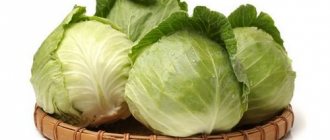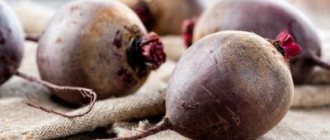Cauliflower is a popular vegetable, one of those that you want to preserve as long as possible and stock up for the winter in various ways. Some people grow it in the garden or in their personal plot, while others buy it in stores and markets. To store cauliflower, especially when fresh, it is important to know how much time has passed since the vegetable was harvested. Therefore, cauliflower grown on your own plot is an ideal option, because in this case the harvest date is known exactly.
Which cauliflower is best stored?
Cabbage, including cauliflower, is classified depending on the ripening time of the heads of cabbage. This is how they distinguish between early-ripening and early-ripening varieties with a growing season of 80 to 110 days, mid-ripening - from 110 to 140 days, and late-ripening - 150 days or more.
Early varieties differ from late-ripening ones not only in the duration of the growing season, but also in the features of development and tissue formation. Late-ripening varieties of cauliflower are more suitable for long-term storage. Storing early-ripening varieties of cauliflower is also possible, but storing it fresh for the whole winter will not work. Early varieties do not differ in so-called keeping quality.
Growing up
Rearing is used for heads, including very small ones (3-5 cm in diameter), which did not have time to ripen due to the early onset of cold weather. Essentially, this is a transplant into the cellar .
Water the cabbage generously 2 days before harvest. Then dig up the heads along with the roots and a clod of soil. Lift the leaves up so that they cover the inflorescences and carefully tie them with a rope. Plant cabbage in pre-prepared boxes with soil or clean sand. The soil layer should be about 15 cm so that it touches the leaves. Important conditions are relative air humidity of at least 95%, temperature from +4 to +10 ℃ and complete absence of light. It is advisable to cover the heads with a wooden shield. From time to time, the basement needs to be ventilated so that the cabbage can “breathe.” The heads will ripen from 1 to 4 months, depending on the variety and time of collection.
Although storing cauliflower may seem a little troublesome, this vegetable is worth the effort: it contains vitamins A, B6, B1, C, PP, as well as calcium, magnesium, phosphorus, iron, does not irritate the gastric mucosa and is easily digestible, so including often serving as the first complementary food for a child.
Maintain an optimal microclimate, do not forget to check the harvest from time to time - and please your household with delicious and healthy dishes made from fresh cabbage!
Storing Freshly Harvested Cauliflower
Cauliflower will not be stored in a warm place for long. The heads collected from the garden should be immediately placed in a place protected from sunlight, choosing as cool as possible. Such recommendations are due to the fact that cauliflower contains a lot of moisture, which, when kept in heat, quickly evaporates, the vegetables dry out, become soft and flabby.
The ideal option is to immediately refrigerate the cabbage; it is best stored at a temperature of 1 to 6°C. Therefore, if it is not possible to place cauliflower in a cellar or refrigerator, where the specified temperature range is maintained, it can be kept on the balcony for some time, trying to maintain the required temperature as much as possible.
It is impossible to expose cauliflower heads to frost even for a short period, as their surface turns black and the taste radically deteriorates and becomes bitter.
In any case, it is necessary to protect the heads of cabbage from light.
How to store cabbage at home in winter
There are many ways to properly store harvested cabbage of different varieties fresh. It all depends on how long at home in an apartment before harvesting the next harvest from a greenhouse or open ground you want to use the fruits without heat treatment. The main condition is compliance with the rules for storing vegetables.
In the cellar
The most convenient way is to store cabbage in a cellar for the winter until spring, especially since there is often a cellar in the city. Some of the options described below are suitable for this; choose according to the size of the room. It is best to make a fence or shelves, and also hang the heads of cabbage from the ceiling.
A mandatory condition: the presence of ventilation to avoid the appearance of dampness and mold in the room. To do this, in dry weather, sometimes leave the cellar open for several hours during the day so that the vegetables are ventilated.
In the pyramid
Build a wooden platform about 10cm above the floor, leaving small gaps between the floorboards. Lay out the bottom row, rectangle, with the largest and densest forks. In the second layer, place smaller cabbages one at a time. Continue laying the pyramid to reduce the number of heads of cabbage.
In a refrigerator
Large heads of cabbage will take up a lot of space; other varieties of cabbage are more convenient to store in the refrigerator. Wrap unwashed fruits with stalks in food paper bags. They will remain fresh at least until the New Year; the rest can be frozen.
In the caisson
A labor-intensive and reliable method, for which you will need to make a hole in the garden and install a special tank with a ventilation pipe there. This is a metal cellar, you can buy it or make it yourself according to the drawings. There are different sizes of the device; cabbage and other vegetables will remain fresh until spring if storage recommendations are followed.
In the pantry
A dry and cool pantry is suitable for storing all varieties. To do this, it must be wrapped in paper or film and placed in wooden or cardboard boxes. If the temperature does not rise above 15°C, the harvest will be fresh until the New Year. You can equip a storage room in the entrance with the consent of your neighbors.
In the underground
If there is an underground floor in a private house or under a balcony on the ground floor, this is a convenient place to store cabbage at home. Make sure that the temperature does not rise above 5°C after turning on the heating
It is important to ventilate the room in a timely manner if there is no separate ventilation to avoid the appearance of dampness and mold.
In paper
This method isolates the fruit, including touching and contamination with possible bacteria. Paper creates insulation and protects from moisture and light. Place the wrapped heads on shelves, drawers or boxes. Keep it dry, wet paper will speed up the rotting of the cabbage.
In the garage
A dry, unheated garage is suitable for storing harvested vegetables from the garden. Set up a separate place for them. Store in boxes or make a fence with sand/sawdust. If severe frosts begin, it is better to move the cabbage to another warmer place.
In boxes
After trimming the stems and removing excess leaves, place the cabbage heads in cardboard boxes. Place them on pallets to slow down damage. There is no need to make a cover, but periodically check for damaged sheets and remove them.
On hooks or ropes
Install a securely fastened rail under the ceiling that will support the weight of the vegetables. Hang heads of cabbage with uncut stalks on hooks attached to the stem. A constant flow of air will prevent the fruits from rotting, the main thing is that there is a distance between them.
Top articles: Freezing watermelon for the winter
In clay
Make a clay solution, coat each head with it in a 0.5 cm layer without gaps and dry. Then put them in drawers or place them on shelves. The inconvenience is that to use the vegetable you will need to soak it in water and then thoroughly wash the softened clay.
In the trench
Dig a 60-degree hole in the garden or yard on a hill, lay straw below and on the walls. Then alternate cabbage and insulation, install a wooden shield on top of this mound and pour a 20 cm thick layer of soil.
In cling film
You can store cabbage in the basement or other dry place with a suitable air temperature using regular cling film in rolls. After wrapping each head of cabbage, place them in a container. The tight-fitting material will preserve vegetables until spring; it has excellent moisture resistance. Place the packaged forks on shelves or store them in boxes.
In wooden boxes
Heads of cabbage stored in boxes practically do not spoil, since there is a constant flow of fresh air. Wrap them additionally in film or paper. Place the containers on pallets 10 cm from the floor, insulate them if necessary if there are severe frosts.
On a note!
To store cabbage, use only boxes made of untreated wood.
In a refrigerator
In a regular refrigerator, as a rule, the temperature that is best suited for storing cauliflower is set - in the range from 0 to +6°C. Therefore, the refrigerator is the optimal way to store cauliflower in an ordinary city apartment.
However, keep in mind that cauliflower will dry out in the refrigerator, so it is better to place it in a plastic bag or wrap it in foil.
Good quality, undamaged cauliflower heads can be stored in the refrigerator for a couple of weeks at most. During storage, they should be periodically inspected for areas of drying out or mold formation. Before storing cauliflower in the refrigerator, the heads should be thoroughly washed and removed from roots and leaves.
In the freezer
You can store cauliflower frozen as a whole head or by disassembling it into inflorescences. To keep the color of the vegetable unchanged,
The prepared cabbage should be immersed in boiling acidified water and blanched for 2-3 minutes, and then quickly cooled in cold water.
Containers suitable for freezing are a tightly closed container or plastic bag that can hold a vacuum.
The shelf life depends on the characteristics of the freezer:
at -6°C cauliflower retains its quality for 2-3 weeks;
at -12°C - several months;
at -12°C - a whole year.
How to make cauliflower for the winter in Korean
Korean-style vegetable recipes have become especially popular in recent years. Now housewives offer to roll cauliflower in this way. Then the winter holidays will go off with a bang! – you just need to cook the meat and serve it, placing spicy and crispy cauliflower on a beautiful dish.
Ingredients:
- Cauliflower – 1 kg.
- Carrots – 3 pcs.
- Garlic – 1 head.
For the marinade:
- Filtered water – 1 l.
- Vegetable oil – 50 ml.
- Sugar – 0.5 tbsp.
- Vinegar – 0.5 tbsp. (maybe a little less).
- Salt – 1-2 tbsp. l.
- Spices for Korean carrots – 1 tbsp. l.
Algorithm of actions:
- According to tradition, divide the head of cabbage, the parts should be small. Blanch the cabbage florets in hot water for 2-3 minutes. Drain the water. Transfer the cabbage to an enamel pan for marinating.
- In a separate container, prepare the marinade itself: put all the ingredients in water, leaving the vinegar. After boiling (5 minutes), add vinegar. While the brine is hot, pour it over the cabbage. Add crushed garlic here.
- Pour grated carrots into a container (chop using a Korean grater) and mix. To cover with a lid. Leave for 5 hours to marinate.
- Place the workpiece in glass containers with a volume of half a liter.
- Sterilize the jars in a pan of boiling water, 10 minutes is enough. Seal and move to a cool place in the morning.
Top articles: Useful preparations: how to freeze beets
Spicy pickled cabbage with carrots and garlic will greatly decorate the table and enrich the diet of your household!
Storing Dried Cauliflower
Cauliflower stores well when dried. This technology allows you to preserve in its composition all the useful and nutritious substances inherent in it and just as quickly prepare any dish from the workpiece.
Blanched inflorescences are dried in an electric dryer or in a slightly open oven at 60°C for 3-5 hours.
The finished product does not release juice when pressed but does not crumble.
You can store dried cabbage in a closed glass jar or in a cotton bag for up to 2 years.
More: Methods for storing feijoa at home
In the form of canned food
Canning is another way to store cauliflower for a long period. You can preserve cauliflower either separately, adding only garlic and spices to taste, or together with tomatoes, cucumbers, small squash, and beets. Such canned food, sealed with tin lids, can be stored until the end of winter if necessary.
The main thing is to thoroughly wash the vegetables and prepare the jars correctly - rinse and sterilize. The cans with lids are covered with a blanket and left to cool completely. It is believed that this is a unique way to prolong the pasteurization process of canned food, which serves to better preserve canned vegetables.
Storing ready-made cauliflower dishes
The peculiarity of storing cauliflower dishes can be considered using the example of fried and stewed vegetables or cauliflower soup. Such dishes should not be stored even refrigerated. The maximum shelf life in the refrigerator is from 3 to 5 days, and at room temperature - within 1 hour, until the prepared dish has cooled down and is put in the refrigerator.
The only way to extend the shelf life of cauliflower as a ready-made dish is to freeze it. This method is used infrequently, but if necessary, the shelf life can be extended to 1-2 months in this way. Frozen foods should be defrosted gradually.
Regardless of the chosen method of storing cauliflower, only vegetables that are thoroughly washed without signs of spoilage are allowed to preserve it in any form. Only intact heads without signs of damage by diseases and pests are stored fresh. It is better to peel the remaining vegetables, select high-quality fragments and use them for preparations.
Saving methods
How to store Chinese cabbage for the winter?
Fresh in the refrigerator
This method has already been discussed above. On an industrial scale, before sale, the heads of cabbage are stored in a refrigerated warehouse, putting them in wooden boxes. In the home refrigerator, after using cling film, it is best to put cabbage in a special compartment for vegetables. If you don’t have one or it doesn’t fit in size, you should buy a large plastic container with a lid.
Top articles: Sportspit
This method allows you to preserve fresh Chinese cabbage for salads, so it is worth considering how many heads of cabbage one person or family will be able to eat so that the product does not go to waste. If the vegetable was grown for soups, then it is better to prepare the cabbage in advance for the winter in another way.
Dried
To dry Chinese cabbage, use an oven or a special electric dryer:
- The outer damaged leaves of the cabbage are cut off, and all the remaining leaves are finely cut into strips.
- Place shredded cabbage in a thin layer in the dryer or oven.
- For the oven, set the temperature to 50-100 degrees, do not forget about the convection mode, or simply leave the door ajar.
- In an electric dryer, the temperature is set to 50-60 degrees.
- It will take 3-4 hours in the oven, about 5 in the dryer.
Then the dried cabbage is put into bags and put in a closet.
It is best to take cotton ones rather than polyethylene - this way the cabbage will not get damp, but at the same time it will “breathe”.
Leaven
Peking cabbage is fermented a little differently than white cabbage. Finely chop 5 kg of cabbage, add 300 ml of water, 50 ml of vinegar, 1 teaspoon each of sugar and salt and 1 clove of garlic passed through a press.
Mix everything and transfer it to where the cabbage will be fermented. The mixture is properly compacted and placed under pressure. After a day, the cabbage is pierced to the bottom, kept for another day at room temperature, and then put into the cold. After 2 weeks it will be ready to eat.
The recipe for pickling Chinese cabbage for the winter is in this video:
Freezing
Pre-shredded frozen cabbage is great for soups. To do this, the outer leaves of the heads of cabbage are also cut off, and the remaining ones are finely chopped and packaged in portions in plastic bags.
Then it is enough to put the preparations in the freezer and store “until required”. Before freezing, the leaves can be blanched in boiling water, for which, after cutting, they are thrown into boiling salted water for 2-3 minutes, drained in a colander and allowed to dry slightly on a paper towel.
You can learn how to freeze broccoli, Brussels sprouts, cauliflower or cabbage from our articles.
In short, Chinese cabbage does not have a long fresh shelf life, but it is not for nothing that Chinese cuisine is famous for its soups and pickles.
To preserve the harvest, finely chopped heads of cabbage can be frozen, dried or fermented.
And those who want to celebrate the New Year with a salad from their own Chinese cabbage should choose the optimal storage conditions for the heads of cabbage and do not forget to check them regularly.











